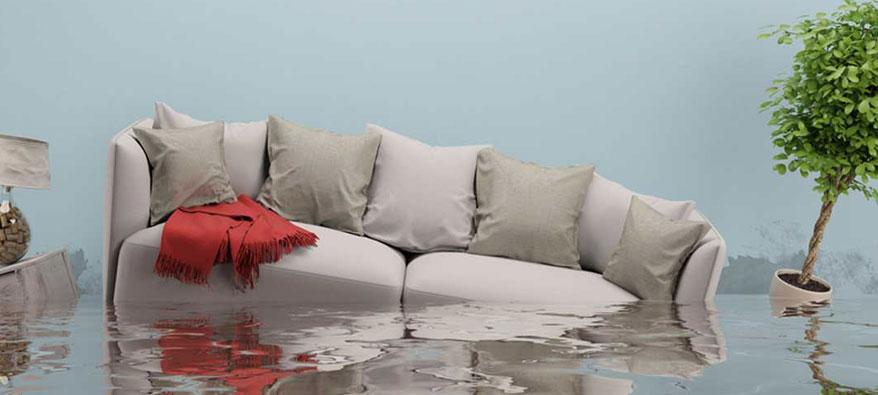Water Damage
Help! I’ve Got Water Damage!
- Stop the source of water! Turn off the main valve to the whole house if need be.
- Check the SAFETY! Turn off any breakers to the affected rooms and unplug any electrical appliances, until you know for certain they are safe.
- Leave the premises if the water is contaminated with sewage.
- Rescue the most valuable items, sentimental things first.
- Remove wet area rugs.
- Place aluminum foil, china saucers or wood blocks between furniture legs and wet carpeting.
- Move photos paintings and art objects to a safe, dry location.
- Remove wet fabrics and dry them as soon as possible. Hang furs and leather goods to dry separately at room temperature.
- Wipe water from wood furniture after removal of lamps and tabletop items.
- Lift draperies off carpet, loop through a plastic (not wire) coat hanger and place the hanger on the drapery rod.
- Remove as much excess water as possible by mopping and blotting.
- Open furniture drawer’s and closet doors.
- Remove damp books from shelves; spread out to dry or freeze them.
- If damage occurs during a cool season leave heat on 60 °F; if damage occurs in summer, use an air conditioner if available.
- Remove and prop up wet upholstery cushions for even drying (check for possible bleeding.)
- Use fans to circulate air and assist drying if the damage has just occurred. (Do not use fans if mold is present.)
![]()
Learn More About the Effects of Water Damage.
Did you know that a water damage event will happen in the average home once every seven years? What is a water damage event? It’s where the washing machine or it’s supply hose bursts and/or leaks all over the floor. It’s where it rains so much that the ground water floods into the low lying areas of your basement or house. It’s the toilet running over and over and over. It’s the water heater springing a leak, and you find it two days later. You are getting the point, now.
It is amazing that we need water so much for our everyday living, to nourish our body, to clean ourselves and our environment. It is also amazing what damage it can do if it gets into and is left in the wrong places. The common thread for almost all life forms is water or at least some moisture.
Why are we delving into the area of science here? The answer is that water is also an important requirement for mildew and mold to grow. The spores that can produce mold are every where in our environment. The are fellow inhabitants of the earth far more numerous than us. When they have all the ingredients they need to proliferate, they do , with a vengeance. The mold spores are microscopic and are everywhere. It is when they colonize that we are able to see the effects. And some feel the effects more than others, when their immune system over-reacts to the off-gassing of the mold colonies. A water event is the time that you have all four conditions for mold to start and grow way out of control, lack of air movement, lack of light, a food source, and water.
In a wet carpet for instance, there is no air movement, or light underneath. The small amount of dirt found in the fibers or even the cotton or jute backing makes for a excellent food source. And finally the water makes for the recipe complete for disaster. In a wall there again, same ingredients, except the paper on the sheetrock, the latex paint, and the wood itself, becomes the fodder for the opportunist mold to come together to be the visible green or black splotches that we see.
Current scientific belief is that if the water source is from clean (uncontaminated) source, you have about 24 hours before the molds get their act together, and start to cause problems. The mold colonies will become visible in another 24 hours. (48 hours from the addition of water.)
Mold damage can be devastating, and measures should be taken to avoid its occurrence. The most important measures are maintaining proper levels of temperature and relative humidity, good circulation of air, and clean, clutter-free storage areas. Ideally temperature should never go above 70°F or relative humidity above 50%.
The higher the temperature and humidity, the greater the risk of mold. If a water-related emergency occurs, such as a flood or fire, wet materials should be dealt with immediately before mold growth develops. Once mold growth appears, the affected contents should be isolated from the rest of the environment. Gloves and a respirator should be worn when handling moldy materials. The items should be dried thoroughly and, once dry, the mold should be removed from them. A water damage restoration specialist should be contacted for advice on how best to deal with this particular situation.
![]()
EMERGENCY SERVICES AVAILABLE
- Insurance Losses
- Water Damage Restoration
- Fire/Smoke Damage
- Odor Control
- Vandalism
- Mold Remediation (performed by Mold & Mildew Solutions LLC)
- 24 Hour Emergency Service
- Advanced Moisture Detection
- Water extraction and dry out
- Work with insurance companies
- Drying Equipment Rental
No one ever thinks about water damage but know To The Rescue will be ready to help when the time comes. Our goal is to help you recover your property to pre-loss conditions as quickly as possible.










